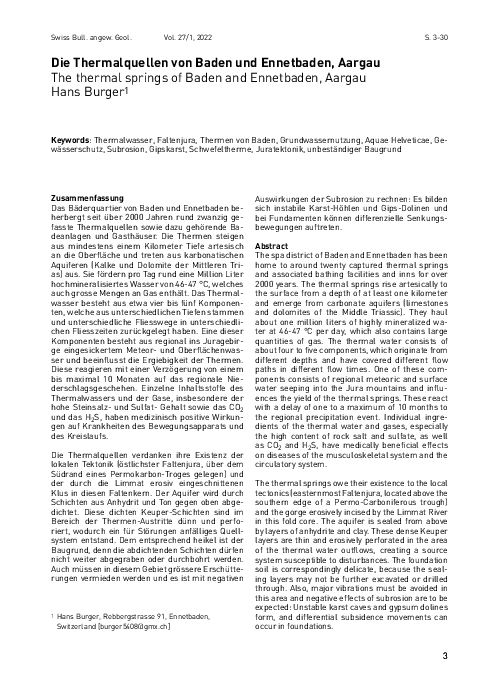External information
Summary - Burger et al. 2022
The spa district of Baden and Ennetbaden has been home to around twenty captured thermal springs and associated bathing facilities and inns for over 2000 years. The thermal springs rise artesically to the surface from a depth of at least one kilometer and emerge from carbonate aquifers (limestones and dolomites of the Middle Triassic). They haul about one million liters of highly mineralized water at 46-47 °C per day, which also contains large quantities of gas. The thermal water consists of about four to five components, which originate from different depths and have covered different flow paths in different flow times. One of these components consists of regional meteoric and surface water seeping into the Jura mountains and influences the yield of the thermal springs. These react with a delay of one to a maximum of 10 months to the regional precipitation event. Individual ingredients of the thermal water and gases, especially the high content of rock salt and sulfate, as well as CO2 and H2S, have medically beneficial effects on diseases of the musculoskeletal system and the circulatory system. The thermal springs owe their existence to the local tectonics (easternmost Faltenjura, located above the southern edge of a Permo-Carboniferous trough) and the gorge erosively incised by the Limmat River in this fold core. The aquifer is sealed from above by layers of anhydrite and clay. These dense Keuper layers are thin and erosively perforated in the area of the thermal water outflows, creating a source system susceptible to disturbances. The foundation soil is correspondingly delicate, because the sealing layers may not be further excavated or drilled through. Also, major vibrations must be avoided in this area and negative effects of subrosion are to be expected: Unstable karst caves and gypsum dolines form, and differential subsidence movements can occur in foundations.
To get the pdf click on the document below.
